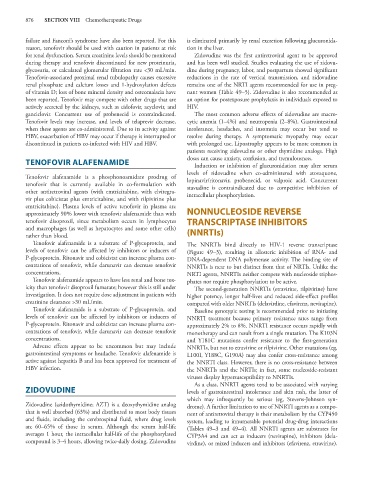Page 890 - Basic _ Clinical Pharmacology ( PDFDrive )
P. 890
876 SECTION VIII Chemotherapeutic Drugs
failure and Fanconi’s syndrome have also been reported. For this is eliminated primarily by renal excretion following glucuronida-
reason, tenofovir should be used with caution in patients at risk tion in the liver.
for renal dysfunction. Serum creatinine levels should be monitored Zidovudine was the first antiretroviral agent to be approved
during therapy and tenofovir discontinued for new proteinuria, and has been well studied. Studies evaluating the use of zidovu-
glycosuria, or calculated glomerular filtration rate <30 mL/min. dine during pregnancy, labor, and postpartum showed significant
Tenofovir-associated proximal renal tubulopathy causes excessive reductions in the rate of vertical transmission, and zidovudine
renal phosphate and calcium losses and 1-hydroxylation defects remains one of the NRTI agents recommended for use in preg-
of vitamin D; loss of bone mineral density and osteomalacia have nant women (Table 49–5). Zidovudine is also recommended as
been reported. Tenofovir may compete with other drugs that are an option for postexposure prophylaxis in individuals exposed to
actively secreted by the kidneys, such as cidofovir, acyclovir, and HIV.
ganciclovir. Concurrent use of probenecid is contraindicated. The most common adverse effects of zidovudine are macro-
Tenofovir levels may increase, and levels of telaprevir decrease, cytic anemia (1–4%) and neutropenia (2–8%). Gastrointestinal
when these agents are co-administered. Due to its activity against intolerance, headaches, and insomnia may occur but tend to
HBV, exacerbation of HBV may occur if therapy is interrupted or resolve during therapy. A symptomatic myopathy may occur
discontinued in patients co-infected with HIV and HBV. with prolonged use. Lipoatrophy appears to be more common in
patients receiving zidovudine or other thymidine analogs. High
TENOFOVIR ALAFENAMIDE doses can cause anxiety, confusion, and tremulousness.
Induction or inhibition of glucuronidation may alter serum
levels of zidovudine when co-administered with atovaquone,
Tenofovir alafenamide is a phosphonoamidate prodrug of lopinavir/ritonavir, probenecid, or valproic acid. Concurrent
tenofovir that is currently available in co-formulation with stavudine is contraindicated due to competitive inhibition of
other antiretroviral agents (with emtricitabine, with elvitegra- intracellular phosphorylation.
vir plus cobicistat plus emtricitabine, and with rilpivirine plus
emtricitabine). Plasma levels of active tenofovir in plasma are
approximately 90% lower with tenofovir alafenamide than with NONNUCLEOSIDE REVERSE
tenofovir disoproxil, since metabolism occurs in lymphocytes TRANSCRIPTASE INHIBITORS
and macrophages (as well as hepatocytes and some other cells) (NNRTIs)
rather than blood.
Tenofovir alafenamide is a substrate of P-glycoprotein, and The NNRTIs bind directly to HIV-1 reverse transcriptase
levels of tenofovir can be affected by inhibitors or inducers of (Figure 49–3), resulting in allosteric inhibition of RNA- and
P-glycoprotein. Ritonavir and cobicistat can increase plasma con- DNA-dependent DNA polymerase activity. The binding site of
centrations of tenofovir, while darunavir can decrease tenofovir NNRTIs is near to but distinct from that of NRTIs. Unlike the
concentrations. NRTI agents, NNRTIs neither compete with nucleoside triphos-
Tenofovir alafenamide appears to have less renal and bone tox- phates nor require phosphorylation to be active.
icity than tenofovir disoproxil fumarate; however this is still under The second-generation NNRTIs (etravirine, rilpivirine) have
investigation. It does not require dose adjustment in patients with higher potency, longer half-lives and reduced side-effect profiles
creatinine clearance >30 mL/min. compared with older NNRTIs (delavirdine, efavirenz, nevirapine).
Tenofovir alafenamide is a substrate of P-glycoprotein, and Baseline genotypic testing is recommended prior to initiating
levels of tenofovir can be affected by inhibitors or inducers of NNRTI treatment because primary resistance rates range from
P-glycoprotein. Ritonavir and cobicistat can increase plasma con- approximately 2% to 8%. NNRTI resistance occurs rapidly with
centrations of tenofovir, while darunavir can decrease tenofovir monotherapy and can result from a single mutation. The K103N
concentrations. and Y181C mutations confer resistance to the first-generation
Adverse effects appear to be uncommon but may include NNRTIs, but not to etravirine or rilpivirine. Other mutations (eg,
gastrointestinal symptoms or headache. Tenofovir alafenamide is L100I, Y188C, G190A) may also confer cross-resistance among
active against hepatitis B and has been approved for treatment of the NNRTI class. However, there is no cross-resistance between
HBV infection. the NNRTIs and the NRTIs; in fact, some nucleoside-resistant
viruses display hypersusceptibility to NNRTIs.
As a class, NNRTI agents tend to be associated with varying
ZIDOVUDINE levels of gastrointestinal intolerance and skin rash, the latter of
which may infrequently be serious (eg, Stevens-Johnson syn-
Zidovudine (azidothymidine; AZT) is a deoxythymidine analog drome). A further limitation to use of NNRTI agents as a compo-
that is well absorbed (63%) and distributed to most body tissues nent of antiretroviral therapy is their metabolism by the CYP450
and fluids, including the cerebrospinal fluid, where drug levels system, leading to innumerable potential drug-drug interactions
are 60–65% of those in serum. Although the serum half-life (Tables 49–3 and 49–4). All NNRTI agents are substrates for
averages 1 hour, the intracellular half-life of the phosphorylated CYP3A4 and can act as inducers (nevirapine), inhibitors (dela-
compound is 3–4 hours, allowing twice-daily dosing. Zidovudine virdine), or mixed inducers and inhibitors (efavirenz, etravirine).

